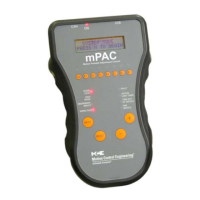F7: Parameters Adjust
4-137
4
Motion 4000
Standard Deceleration, 169 Determines the maximum deceleration for this profile.
The maximum value is typically 4.0 ft/s
2
and the minimum is usually not less than 2.0 ft/s
2
with more common values ranging from 2.75 ft/s
2
to 3.75 ft/s
2
(0.838 to 1.143 m/s
2
). The value
of Deceleration is usually slightly less than the value of Acceleration (by 0.25 to 0.5).
Manual Start Jerk, 170 Defines the transition from zero speed to full acceleration. As
Start Jerk increases, the profile transitions more quickly from starting to maximum accelera-
tion. Values typically range from 4.0 to 8.0 ft/s
3
(1.219 to 2.438 m/s
3
) with higher values result-
ing in a sharper start.
Manual Roll Jerk, 171 Roll Jerk determines how quickly the profile transitions from
maximum to zero acceleration and zero to maximum deceleration. As Roll Jerk increases, the
profile transitions more quickly. Typical values range from a minimum of 4.0 ft.
Manual Stop Jerk, 172 Defines the transition from deceleration to stop. As Stop Jerk
increases, the profile transitions more quickly.
Manual Acceleration, 173 Determines the maximum acceleration for the profile.
Determines the maximum current delivered by the AC Drive during acceleration. The maxi-
mum value is typically 4.0 ft/s
2
(1.219 m/s
2
) and the minimum is usually not less than 2.5 ft/s
2
(0.762 m/s
2
).
Manual Deceleration, 174 Determines the maximum deceleration for this profile.
The maximum value is typically 4.0 ft/s
2
and the minimum is usually not less than 2.0 ft/s
2
with more common values ranging from 2.75 ft/s
2
to 3.75 ft/s
2
(0.838 to 1.143 m/s
2
). The value
of Deceleration is usually slightly less than the value of Acceleration (by 0.25 to 0.5).
Danger Start Jerk, 175 The Danger profile is used for emergency slowdown. If, after
stopping, the car restarts while remaining on the Danger curve, this setting defines the transi-
tion from zero speed to full acceleration. As Start Jerk increases, the profile transitions more
quickly from starting to maximum acceleration.
Danger Roll Jerk, 176 Roll Jerk determines how quickly the profile transitions from
maximum to zero acceleration and zero to maximum deceleration. As Roll Jerk increases, the
profile transitions more quickly.
Danger Stop Jerk, 177 Defines the transition from deceleration to stop. As Stop Jerk
increases, the profile transitions more quickly.
Danger Deceleration, 178 Determines the maximum deceleration for this profile.
Alternate Start Jerk, 179 Defines the transition from zero speed to full acceleration.
As Start Jerk increases, the profile transitions more quickly from starting to maximum acceler-
ation. Values typically range from 4.0 to 8.0 ft/s
3
(1.219 to 2.438 m/s
3
) with higher values
resulting in a sharper start.

